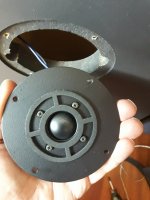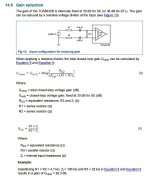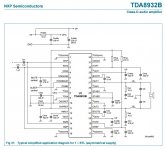For a power supply you mean? No idea to me power supplies are commodities - do you want a PCB, open frame type or fully enclosed?
I'd say open frame is better for me.
What do you think, something like this is okay? It would be better if I could use for other amplifier.
ALIMENTATORE UNIVERSALE NOTEBOOK USB AUTO CASA ACER ASUS HP TOSHIBA LINQ IT 150W | eBay
DC24V 6A 150W Switching Power Supply Board Power Supply Module | eBay
Someone told the second one was good in the forums, but the first would arrive in a week, while the other it would take 2 months to arrive, so I would prefer to take the first one. What do you think? Would the first one be good for my goals?
What do you think, something like this is okay? It would be better if I could use for other amplifier.
ALIMENTATORE UNIVERSALE NOTEBOOK USB AUTO CASA ACER ASUS HP TOSHIBA LINQ IT 150W | eBay
DC24V 6A 150W Switching Power Supply Board Power Supply Module | eBay
Someone told the second one was good in the forums, but the first would arrive in a week, while the other it would take 2 months to arrive, so I would prefer to take the first one. What do you think? Would the first one be good for my goals?
I tried several different laptop power supplies which had switchable voltages. Might be this one in your first link behaves differently but all the ones I tried had periodically clicking noises, extremely annoying I have to say.
The second one seems to be identical to the one I bought half a year ago and works flawlessly. I would recommend that one.
The second one seems to be identical to the one I bought half a year ago and works flawlessly. I would recommend that one.
I'd say open frame is better for me.
What do you think, something like this is okay? It would be better if I could use for other amplifier.
ALIMENTATORE UNIVERSALE NOTEBOOK USB AUTO CASA ACER ASUS HP TOSHIBA LINQ IT 150W | eBay
DC24V 6A 150W Switching Power Supply Board Power Supply Module | eBay
Someone told the second one was good in the forums, but the first would arrive in a week, while the other it would take 2 months to arrive, so I would prefer to take the first one. What do you think? Would the first one be good for my goals?
You can find the second one and a labeled 9A version around 8 - 10 USD incl. shipping on ebay and aliexpress. I used them with some TPA3116D2 boards and I can recommend them.
24V would be the minimum I'd want to run it at.
With TDA8932BT, I been at 18.5vdc linear regulated switchmode, old school. And, that was used bridge mode for the woofer, SE mode for the 6db more efficient tweeter (returned to power ground via series cap).
Seems minimal, right? Sure did wipe off the need of anything else to use indoors.
I got spendy amps, and its coming up on a year when those haven't been plugged in once. Maybe that's an odd way to say that there are some effective ways to use the TDA8932BT? I have been using that. . .
It did happen to readjust my opinion on what were minimum figures.
I like amplifiers that work like this because they give me an idea on what I should make amplifiers do. That'll cost a mint on a big amp (but I don't need a bigger amp indoors).
Thank you for the reminder.Hello Daniel, you have not responded to my post # 367 and 368?
The 13.5vdc 5a example works fine.I understand, thanks for the tips. I have some other question for when you have the time:
- Can I use a regulated power supply 13.5V - 5A? Or should I use a universal power adapter 12-24 volt?
- I have 2 tweeter 2 of 3.6 cm soft dome. Are they fine ?
- the capacitor to be plugged must be made of polypropylene or electrolytic of 1uf and how many volts does it needs?Can you advise me on something to use?
- I draw a diagram (you can find it below) of how to connect the tweeter. Is it okay?
- can I use a pot 50k removed from a TDA7297?
You did not specify the current capacity of the universal power adapter. Multiply the volts times the amps and the subtract the efficiency difference of the amplifier and then determine if that hits your goals on power output for watts.
Dome tweeters? Due to vast variance, I'm not taking any questions about dome tweeters. Forward to the speaker forum for those.
50k pot is almost always a good bet for audio line level audio pot. It isn't too much and it isn't too little. If that's your first guess, its really good!
However, do you own vintage/elderly sources that don't have onboard volume controls? Well, 80's VCR and 90's CD players are really loud sources that might cause the need of the volume pot. However, if you have modern sources with onboard volume controls, then it is unlikely that you'd need a volume pot on a small scale power amplifier.
Well, use them for woofers, and roll the dice again from a different vendor to get TDA8932BT to drive your tweeters. There's nothing that I can do about the shopping hazard of electronic parts, all of them, including these.Today I received 2 amp tda8932 but unfortunately I was deceived, they sent the tda8932T me. How do I make the change in the SE.?
But, those that you got in the mail, can certainly work well for indoor use of woofers, mid-basses, and midranges. In that way they can be used in a bi-amp arrangement (somewhat after you acquire a suitable treble amplifier for your tweeters).
I also had that particular inconvenience. But, on some effort, I got the TDA8932BT more than half of the time.
Hadn't actually meant to enjoy this on the 15th of July 2015
A bit later 4th of March 2017, it is still in service.
It is in service in SE mode for the tweeters.
And, there may have been some bridge mode fun for only the woofers.
There went with a facts-only post.
A bit later 4th of March 2017, it is still in service.
It is in service in SE mode for the tweeters.
And, there may have been some bridge mode fun for only the woofers.
There went with a facts-only post.
So, do you need the TDA8932BT for the single-end application? And the TDA8932T can't be modded? How does modifying the TDA8932BT for SE works, in layman terms?
I got a TDA8932BT board, the performance quality is high. But I had a question - who uses the adjustment of the output signal level with the help of the timbre-block unit. Share the data that you use to adjust the output signal (perhaps from pre-built boards timbre-block on ebay and aliexpress) and what are the results?
So, do you need the TDA8932BT for the single-end application? And the TDA8932T can't be modded? How does modifying the TDA8932BT for SE works, in layman terms?
His posts starting 8th January 2016....
http://www.diyaudio.com/forums/clas...tda8932-pessimistic-review-9.html#post4575284
J.
Unmodified TDA8932T (and TDA8932BT) can be used for woofers.So, do you need the TDA8932BT for the single-end application? And the TDA8932T can't be modded? How does modifying the TDA8932BT for SE works, in layman terms?
TDA8932BT in SE mode (you'd add one cap sized to suit only what the tweeter needs--the cap series to power ground is used for speaker ground, then you use only One of the amplifier board's speaker contacts) that can do much higher resolution treble (high fidelity treble).
Utilizing this method involves adapting your speakers to support Bi-Amp hookup, along with twice the number of speaker hookup cables.
Perhaps you'd like to explore the Speakers portion of diyaudio.com and find out all about bi-amp? It seems like that is the place to start.
Hello Daniel, this scheme post 367 all right?
https://postimg.org/image/429h21fpv/
The wire going to the 1u needed to be sketched in black pen because it is still ground. The wire going out of the 1u needed to be sketched in any color other than red.
The 1u may be too small. However, it is within the expected range of 1u~10u. Therefore, it is also possible that it would work perfectly.
The super-tweeters added to the top of the speaker, in the sketch, appear be large bi-cone speakers, which would not be very efficient in producing the uppermost treble. If it was like the 8" dual-cone speakers in the ceiling of my grocery store, run through a 1u cap (that what the drawing looks like), then you might not hear the output. You will want a 3/4" (or smaller dome), a wee little dynamic horn, a paper tweeter of 2" or smaller, or a ribbon/planar/electrostatic tweeter. Given the super-tweeter (assistant tweeter) task, then the part to use won't be to the scale of the drawing. Also, note the output power difference in SE mode--The added super-tweeter needs to be 6db more efficient than the main speaker.
At the bottom of the drawing, the 24v supply is going to the TDA8932 driving a woofer in bridge mode. This works, but it also incurs the need of a heatsinking effort so that the amp doesn't simply shut off every time you turn up the volume knob. We did test high power bass output, and if you want that, then, necessarily, you want a heatsink. Just saying that if there wasn't a heatsink, you might want to pull that voltage spec down to 18vdc~19vdc or so. Even that much will shut off at max, but the figures are closer and you'd probably enjoy trying it. Might like a heatsink even more. So, that was worth a mention for powering your woofers.
Except for this list of, possibly unimportant, nitpicks, the drawing should work delightfully.
P.S.
So that the drawing mentioned doesn't evaporate, I have attached it to this post. It does look, just like, how you attach an efficient super-tweeter (small assistant-tweeter) up to a bridge amp, for higher audio resolution output. The cap size and tweeter size might not be to scale for broad application. The added super-tweeter needs to be 6db more efficient than the main speaker.
Attachments
Last edited:
Anyhow, it sure did look like you were about to take the fast trip to hi-fi, except that your high-frequency tweeters probably should fit easily into the palm of your hand.
For the highest audio frequencies, the voice coil needs to be significantly smaller than that of the 8" Pioneer B20. 🙂
For the highest audio frequencies, the voice coil needs to be significantly smaller than that of the 8" Pioneer B20. 🙂
The wire going to the 1u needed to be sketched in black pen because it is still ground. The wire going out of the 1u needed to be sketched in any color other than red.
The 1u may be too small. However, it is within the expected range of 1u~10u. Therefore, it is also possible that it would work perfectly.
The super-tweeters added to the top of the speaker, in the sketch, appear be large bi-cone speakers, which would not be very efficient in producing the uppermost treble. If it was like the 8" dual-cone speakers in the ceiling of my grocery store, run through a 1u cap (that what the drawing looks like), then you might not hear the output. You will want a 3/4" (or smaller dome), a wee little dynamic horn, a paper tweeter of 2" or smaller, or a ribbon/planar/electrostatic tweeter. Given the super-tweeter (assistant tweeter) task, then the part to use won't be to the scale of the drawing. Also, note the output power difference in SE mode--The added super-tweeter needs to be 6db more efficient than the main speaker.
At the bottom of the drawing, the 24v supply is going to the TDA8932 driving a woofer in bridge mode. This works, but it also incurs the need of a heatsinking effort so that the amp doesn't simply shut off every time you turn up the volume knob. We did test high power bass output, and if you want that, then, necessarily, you want a heatsink. Just saying that if there wasn't a heatsink, you might want to pull that voltage spec down to 18vdc~19vdc or so. Even that much will shut off at max, but the figures are closer and you'd probably enjoy trying it. Might like a heatsink even more. So, that was worth a mention for powering your woofers.
Except for this list of, possibly unimportant, nitpicks, the drawing should work delightfully.
P.S.
So that the drawing mentioned doesn't evaporate, I have attached it to this post. It does look, just like, how you attach an efficient super-tweeter (small assistant-tweeter) up to a bridge amp, for higher audio resolution output. The cap size and tweeter size might not be to scale for broad application. The added super-tweeter needs to be 6db more efficient than the main speaker.
Thanks for the answer. I am waiting to receive the 2 TDA8932BT boards but in the meantime I'm using the 2 TDA8932T boards powered by 13.5V 5a. The sound is very pleasant, it has good bass. I inserted a 50k logarithmic potentiometer and connected it to the audio Chromecast. By phone I launch flac files and frequently listen to Spotify premium. I like it very much how you hear the music from TDA8932T but the only problem I have is when I raise the volume up because there is a persistent distorted sound in the background (like frying oil, to use a metaphor). It isn't a problem for me because I live in a condo so in conclusion I like TDA8932 more than tpa3116 / tpa3118 mono sanwu .. I can't wait to try the TDA8932BT.
Meanwhile, while I wait for the boards to arrive, I'll upload there the pictures of the tweeters available at the moment. Do remember that my speakers range between 87 and 90 db, so if these ones aren't fit, I would ask you to link me a website where to find something more fit for my needs.
Attachments
Its possible your apparent distortion is due to noise pick-up at the input wires. I've found the best way to avoid this effect is to use an input transformer in conjunction with some 1k series Rs soldered right at the amp input pins.
Its possible your apparent distortion is due to noise pick-up at the input wires. I've found the best way to avoid this effect is to use an input transformer in conjunction with some 1k series Rs soldered right at the amp input pins.
Hello Abraxalito. Unfortunately, I'm not an expert in electronics as the first time I learned how to weld and tampering with devices while reading the TDA7297's thread (with great satisfaction, if I may add). Given that, I would like to ask you if you could suggest me where I can purchase an input transformer. Then I would like to ask you if this issue can be found only on the TDA8932T or it can be found in the TDA8932BT too. I'm asking you about it because I have already ordered 2 TDA8932BT (and a FDA Alientek D2). I like all these amplifiers and I'm still trying to figure out which one is the best. Thanks to you all of the forum for helping me.
Try these (that ChuckT found over on another classD thread) - https://item.taobao.com/item.htm?spm=a1z09.2.0.0.KvaKyt&id=39991111619&_u=85skkbbe486
To answer your other question - I think noise is an issue no matter the variant (B or non-B) of the chip.
To answer your other question - I think noise is an issue no matter the variant (B or non-B) of the chip.
The noise seems to be caused mainly by the very high gain of 30dB (SE-mode) respective 36dB (BTL-mode). There are no pins for changing the gain directly, the datasheet indeed DOES mention about the gain reduction though.

That has to be applied to pins 2 & 3 and 14 & 15 respective before the parallel wiring in BTL mode.

Did anyone try these modifications already?
That has to be applied to pins 2 & 3 and 14 & 15 respective before the parallel wiring in BTL mode.
Did anyone try these modifications already?
Attachments
- Home
- Amplifiers
- Class D
- Fasten seat belts. TDA8932 pessimistic review.
![20170209_161423[1].jpg](/community/data/attachments/559/559021-fb4cdaa6696ce32c9c00b53e03488143.jpg?hash=-0zapmls4y)



